It’s no secret that I don’t like most freeze-dried backpacking meals. Virtually all of those freeze-dried meals for backpacking are lacking nutrients, have small portion sizes, and are very overpriced.
However, that doesn’t mean that those pouches of backpacking food are all bad. Even if you take the DIY approach to backpacking meals, it’s still nice to bring along a pouch or two for convenience sake.
I’ve compiled a list of the best backpacking food brands based on factors like ingredients, protein content, calories per pouch, calorie density, and (of course) taste. If you want to know more about how these meals were chosen, scroll down. Otherwise, here’s the best meals for backpacking.
Quick Picks:
- Best Overall: AlpineAire. Their meals are affordable, have a good caloric density, lots of protein, and aren’t overloaded with sodium. It’s a good middle ground of everything you could want. I just wish they have more flavors to choose from. Aailable at Amazon
 , REI.
, REI. - Best Tasting: Peak Refuel. These backpacking meals taste delicious without having to add too many artificial ingredients. They also happen to be loaded with protein – about 40g per pouch – and have a high calorie density of around 130/oz. Available here.
- Easiest Solution: RightOnTrek. They have a cool free meal planner tool that allows you to order exactly how many calories you need for your trip. The brand uses eco-friendly packaging and the meals are healthy and affordable. Available here.
Want to make your own cheap, healthy backpacking meals?
Get my dehydrator recipes book.
It has over 50 healthy ultralight recipes plus tons of info on meal planning for backpacking trips.
Comparison of Top Backpacking Meal Brands
*Based on averages of three popular dinners
| Calories/ Pouch | Calories/Oz | Sodium | Protein | Price | |
|---|---|---|---|---|---|
| Mountain House | 600 | 125 | 1,640mg | 30g | $ |
| Backpacker's Pantry | 640 | 120 | 2,030mg | 38g | $ |
| AlpineAire | 600 | 115 | 1,200mg | 35g | $ |
| RightOnTrek | 550 | 110 | 986 | 26g | $ |
| Wild Zora | 395 | 130 | 640mg | 36g | $$$ |
| Next Mile Meals | 546 | 146 | 1,260mg | 54g | $$$$ |
| Good-to-Go | 710 | 107 | 1,020mg | 26g | $$ |
| Peak Refuel | 670 | 128 | 1,390mg | 41g | $$ |
Tip: When you buy 8 or more backpacking meals on REI, you’ll get 10% off.
Backpacking Meals Reviewed
Here’s where I’ve broken down the nitty gritty about each top backpacking meal brand, including the typical amount of calories per pouch, calorie density, nutrition, taste, and cost.
Mountain House Backpacking Meals
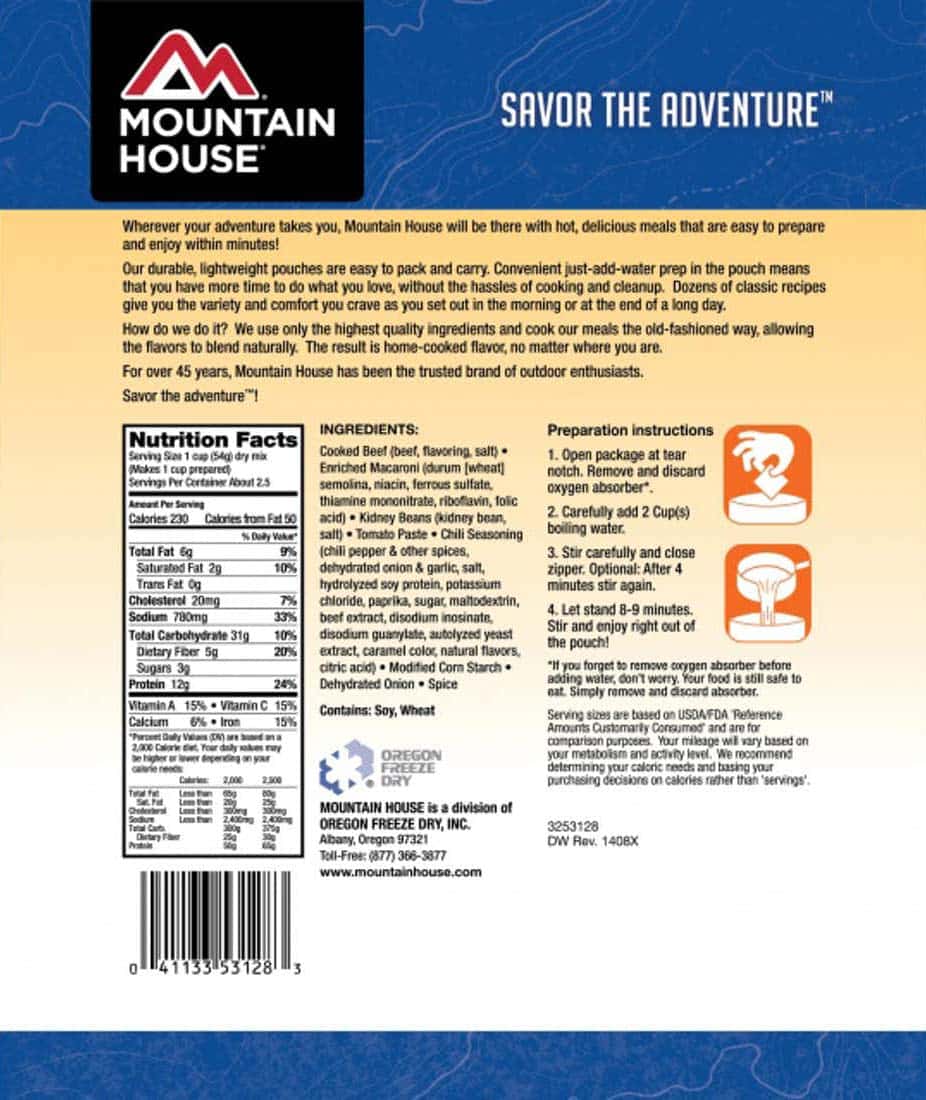
Verdict: Mountain House meals taste great and have a good amount of calories per weight, but there is a huge amount of sodium. Not for people who want to eat healthy on the trail!
Quick Overview:
- Calories per pouch: 600
- Weight: 125 calories/oz
- Sodium: 1640mg
- Protein: 30g
- Price: $
- Where to buy: Amazon
 , REI
, REI
Review:
Mountain House is one of the better-tasting brands of backpacking food. This probably has to do with the fact that they use real meat in their meals instead of just “meat flavor” like you’ll see in other brands. There is also a lot of cheese in their meals, which adds a lot of flavor.
All of this meat and cheese makes Mountain House meals full of protein. That will help your muscles recover quickly on the trail.
When it comes to other aspects of nutrition though, Mountain House is far from ideal. Their meals have huge amounts of sodium in them. Their Beef Stroganoff with Noodles, for example, has 2000mg of sodium per 650 calories.
At least their nutrition facts are easy to understand. A pouch usually has 2 servings that add up to around 600 calories. Expect to each an entire pouch for dinner. The caloric density breaks down to around 125 calories/oz, which is in line with what you should be aiming for backpacking.
Get Mountain House meals here on Amazon![]() or REI
or REI
Backpacker’s Pantry Meals
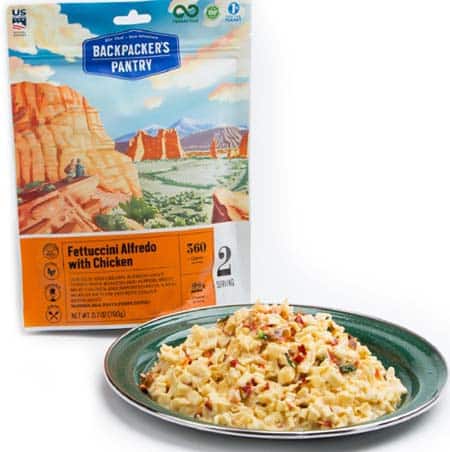
Verdict: If you are bored with typical backpacking meals and don’t mind the huge amounts of sodium, there are some interesting gourmet dinners to choose from.
Quick Overview:
- Calories per pouch: 640
- Weight: 120 calories/oz
- Sodium: 2030mg
- Protein: 38g
- Price: $
- Where to buy: Amazon
 or REI
or REI
Review:
After Mountain House, Backpacker’s Pantry is the most popular brand of freeze-dried backpacking food. What makes them stand out is that they have more exciting flavors of meals such as: Pesto Pasta with Salmon, Chana Masala, and Cuban Coconut Beans and Rice.
Like Mountain House, they do use real meat in their meals. I just wish they’d put in more veggies too instead of loading them with cheese and butter sauces.
Most of their backpacking dinners have loads of protein in them. For example, the Fettucini Alfredo with Chicken has 44g of protein per pouch (610 calories total). The Shepherds Potato Stew with Beef has 32g of protein per pouch (560 calories).
As with most backpacking dinners, these meals are loaded with sodium. Expect around 2000mg of sodium – which is already nearing the USDA upper limit for sodium.
All of this meat and cheese makes Mountain House meals full of protein. That will help your muscles recover quickly on the trail.
The one thing that I really like about Backpacker’s Pantry is that they have some more interesting meals. It isn’t just stews and pasta. So, if you are going on a long backpacking trip and need some variety, you’ll want to choose some of these.
Get Backpacker’s Pantry meals here on Amazon![]() or REI
or REI
AlpineAire Backpacking Meals
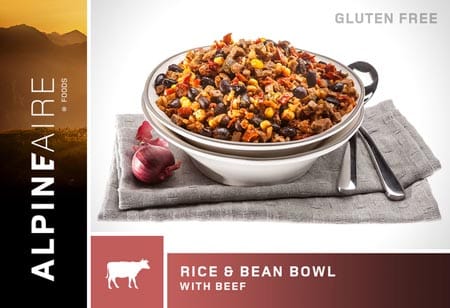
The Verdict: AlpineAire meals use ingredients that you can recognize, aren’t loaded with tons of sodium, taste good, have a decent caloric density, and are fairly priced. This is why they got my “Best Overall” pick.
Quick Overview:
- Calories per pouch: 600
- Weight: 115 calories/oz
- Sodium: 1,200mg
- Protein: 35g
- Price: $
- Where to buy: Amazon
 or REI
or REI
Review:
AlpineAire has been around since 1979 but only got popular once Katadyn bought them in 2012. They don’t have as many options as other backpacking meal brands, but the options they do have are great. It seems that AlpineAire is striving to make healthier alternatives to typical backpacking meals. They use “all natural” ingredients including real freeze-dried meat and veggies (hooray for micronutrients!).
A big standout is that AlpineAire has kept their sodium levels under control. Some meals (like the Spicy Sausage Pasta) only has 880mg per pouch. Other meals do have much more sodium though (like the Black Bart Chili with Beef and Beans which has 1500mg of sodium). If sodium matters to you, pay attention to the nutrition labels before choosing a meal!
The protein levels of the backpacking dinners is decent. They range from around 24g to 50g per pouch. A pouch usually has around 600 calories, which puts the caloric density around 110 to 120 calories/oz. Not great, but far from bad too.
The only real issue with AlpineAire is that they don’t offer much variety. Most of their meals are some variation of the standard, like chili, rice and beans, or cheesy pasta. If you are on a long backpacking trip, I’d get some meals from another brand to keep things exciting.
Get AlpineAire meals here on Amazon![]() or REI
or REI
RightOnTrek Backpacking Meals
The Verdict: This small brand has healthy, freshly-cooked gourmet backpacking meals in eco-friendly packaging. It’s a bit more work to make the meals but it is worth it. The meal planning tool also makes trip planning so easy!
Quick Overview:
- Calories per pouch: 550
- Weight: 110 calories/oz
- Sodium: 986mg
- Protein: 26g
- Price: $
- Where to buy: RightOnTrek website
Review
RightOnTrek is a bit different than other backpacking meal brands. For starters, they have a free meal planning tool. You set the number of days, calories, and food preferences. Then it lists everything you need for the trip and lets you buy it all with a few clicks. If you don’t like an item in the plan, no problem – just swap it for another item. The meal planner calculates calories and weight for you, so it really couldn’t be easier to plan food for your trip.
All meals are made fresh each season by a real chef (not a factory). Then they are dehydrated and packaged. RightOnTrek is all about being eco-friendly and use biodegradable packaging for their meals. The meals taste delicious, though many do require a multi-step cooking process. This means you get a really good texture to the food instead of a gross mush. IMO, it’s worth the extra effort to have food which actually has texture.
You can read my full review of RightOnTrek here. Or visit their website to start shopping here.
Wild Zora Backpacking Meals
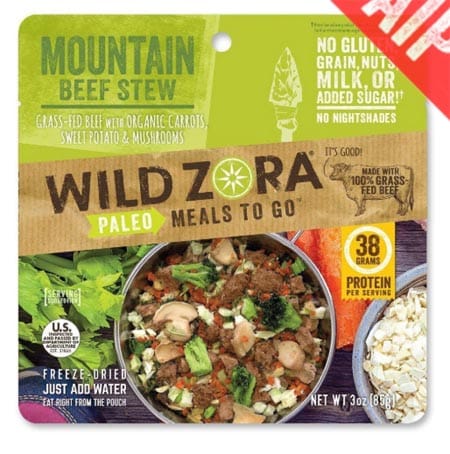
The Verdict: Very healthy and lots of protein, but expensive and lacking in calories. Be prepared to eat more than one package of Wild Zora meals (and pay the high cost!) or bring along your own grains to eat with their meals.
Quick Overview:
- Calories per pouch: 395
- Weight: 130 calories/oz
- Sodium: 640mg
- Protein: 36g
- Price: $$$
- Where to buy: Amazon, REI
Review:
WildZora makes paleo freeze-dried meals. That means they meals contain no grains, no dairy, and no artificial ingredients. They are definitely a healthy option but, without grains, a bit lacking in calories.
The ingredients list on Wild Zora backpacking meals is refreshingly simple. You’ll see only ingredients like “grass-fed beef” and freeze-dried vegetables. The quality of the food seems pretty high, and the flavor reflects this.
Since the meals are meat-based, they are loaded with protein. There is an okay amount of fat and low levels of sodium.
The main issue with Wild Zora meals backpacking is that they have very few calories. A typical backpacker will need around 3,500 calories per day. Of those calories, about 600-700 will be for dinner. That means you’d need to eat two Wild Zora meals to get enough calories.
Considering that Wild Zora meals cost about $14 per pouch, that expense is going to add up quickly!
If you aren’t on the paleo or AIP diet, you could bring your own instant rice, pasta, tortillas, or other carbs to eat with the meal. Or, if you don’t eat grains, get some freeze dried sweet potato hash to go with meals. I’d get sick of eating sweet potatoes every day though!
Get Wild Zora meals here on Amazon or REI
Next Mile Meals
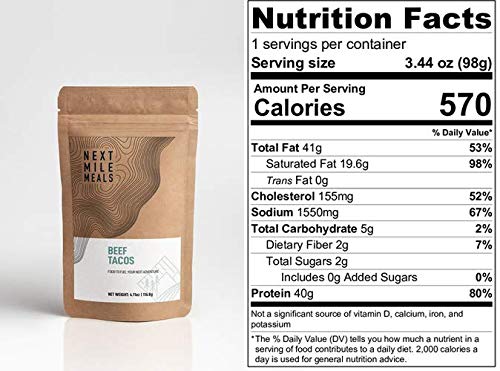
The Verdict: At this price, I’d recommend making your own backpacking meals from bulk freeze-dried ingredients.
Quick Overview:
- Calories per pouch: 546
- Weight: 146 calories/oz
- Sodium: 1,260mg
- Protein: 54g
- Price: $$$$
- Where to buy: Amazon
Review:
Next Mile Meals makes ketogenic, low-carb backpacking meals. Some of their most popular dinners are Beef Tacos, Chicken Coconut Curry, and Deli Beef. They have variety packs you can buy, but the packs include breakfasts too.
At first glance, Next Mile Meals seem like a backpacker’s dream. The caloric density of meals is around 130 to 160 per ounce. That will seriously cut back on weight! But, at closer glance, the meals are far from ideal.
For starters, there are currently only 6 entrees to choose from. Most of these meals contain only meat with a bit of flavoring. There aren’t any grains and very few veggies. I know that’s the point of a ketogenic diet, but you’ll probably feel hungry on intense backpacking trips.
Since the backpacking meals mostly contain meat, they seem very overpriced. You can buy freeze dried meat for a fraction of the cost. Just put the freeze-dried meat into a bag with some seasonings, and add some freeze-dried veggies if you want. It’s cheaper and will have a lot less sodium than the Next Mile Meals.
Good To-Go Backpacking Meals
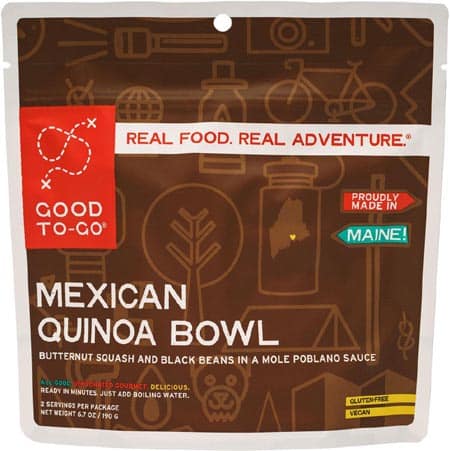
The Verdict: The calorie density of these backpacking meals isn’t great. But they make up for it by using quality ingredients and packing in lots of flavor. Vegetarians will particularly love these backpacking meals.
Quick Overview:
- Calories per pouch: 710
- Weight: 107 calories/oz
- Sodium: 1,020mg
- Protein: 26g
- Price: $$
- Where to buy: Amazon
 or REI
or REI
Review:
The backpacking meals by Good To-Go are the only ones reviewed here that are dehydrated (as opposed to freeze dried). To make the meals, you just pour boiling water into the pouch. Close the pouch and wait 15 minutes. You’ve got a meal!
Good To-Go has tried to differentiate themselves from other brands by only using natural ingredients. They even write on their ingredients list “Notice how many you can pronounce!” There’s still a lot of sodium in their meals, but it isn’t nearly as bad as most backpacking meals.
Right now, they only have 10 different meals to choose from. Some of them are really exciting and gourmet, like the Pad Thai and Chicken Gumbo. The price is slightly higher than the leading brands, but you can get meal packs for a better deal.
Get Good To-Go meals here on Amazon![]() or REI
or REI
Peak Refuel Backpacking Meals
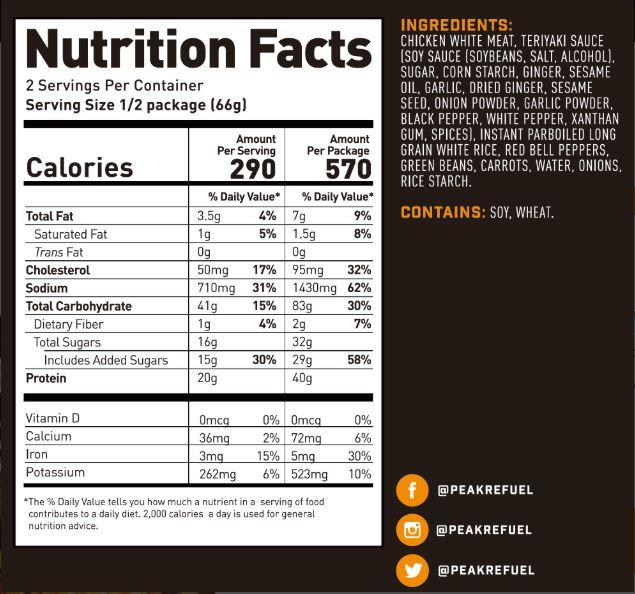
Verdict: These are definitely tasty, nutritious meals that will fuel your body on long backpacking trips. The meals are pricy, but not as much as other backpacking meals of similar quality.
Quick Overview:
*Based on averages of 3 popular dinners
- Calories per pouch: 670
- Weight: 128 calories/oz
- Sodium: 1,390
- Protein: 41g
- Price: $$
- Where to buy: Amazon

Review:
Based in Utah, Peak Refuel stands out by making high-protein backpacking meals that require less water and time than other brands to hydrate.
The first thing that stands out about Peak Refuel is the huge amounts of protein per pouch. Most of the meals have around 40g of protein. Their beef pasta even has 49 grams. It’s recommended that you get at least 1g of protein per kilogram of bodyweight – a recommendation that a lot of backpackers fall short on.
As for ingredients, not all of them are “natural” or even pronounceable. However, there is a decent amount of real meat in the meals. Almost all of their backpacking meals are loaded with buttery sauce or cheese, so they definitely taste great (it’s hard to go wrong with cheese!).
Each pouch contains around 670 calories, which will definitely fill you up after a long day of hiking. The protein levels are also very high at around 41g per pouch. The sodium is high, but not as bad as Mountain House meals.
How I Chose the Best Backpacking Meals
There are now dozens of different brands of backpacking meals. In choosing the “best” ones, I looked at these factors:
1. Calorie Density
Backpacking meals should ideally have at least 120 calories per ounce. That will allow you to carry 3,500 calories of food in 1.8lbs (822g).
2. Healthiness
I looked at the ingredients list for the most popular backpacking dinners. Did the meals contain real meat? Any vegetables? Did they use chemical flavor enhancers?
I also paid particular attention to the levels of protein and sodium in the meals. Backpacking is no time to skimp on protein – you want your muscles to recover! As for sodium, backpackers aren’t exactly at risk of high blood pressure. However, all that extra sodium in typical backpacking meals can cause your feet to swell.
3. Taste
There is a huge tradeoff between taste and healthiness. The best-tasting backpacking meals are usually loaded with huge amounts of sodium, not to mention MSG and other chemical flavors.
Obviously taste is a subjective thing. I factored in the quality of ingredients as well as what backpackers said about the meals.
4. Cost/Value
Backpacking meals are not cheap. You can expect to pay around $9 per pouch. Some cost over $16 per pouch. Yes, you will probably be eating the entire pouch – even when it says “2 servings.”
The value was based on the amount of calories you get per pouch, as well what the meal actually contains. For example, is the meal just a bunch of pasta with a few scraps of meat thrown in? Or are you getting a nutritious meal with lots of quality ingredients in it.
DIY Backpacking Meals?
As I mentioned before, I rarely eat freeze-dried backpacking meals. While they do make meal planning easier, they are overpriced and lack nutrients. Plus, most of them are just glorified pasta and not worth paying $9+ per pouch for.
Instead, I either make my own backpacking meals from supermarket ingredients (click the link for meal ideas). Or, I dehydrate backpacking meals.
I can dehydrate awesome sauces for things like couscous or pasta. Or I’ll even dehydrate entire meals. Below you can see what some of my backpacking meals look like.
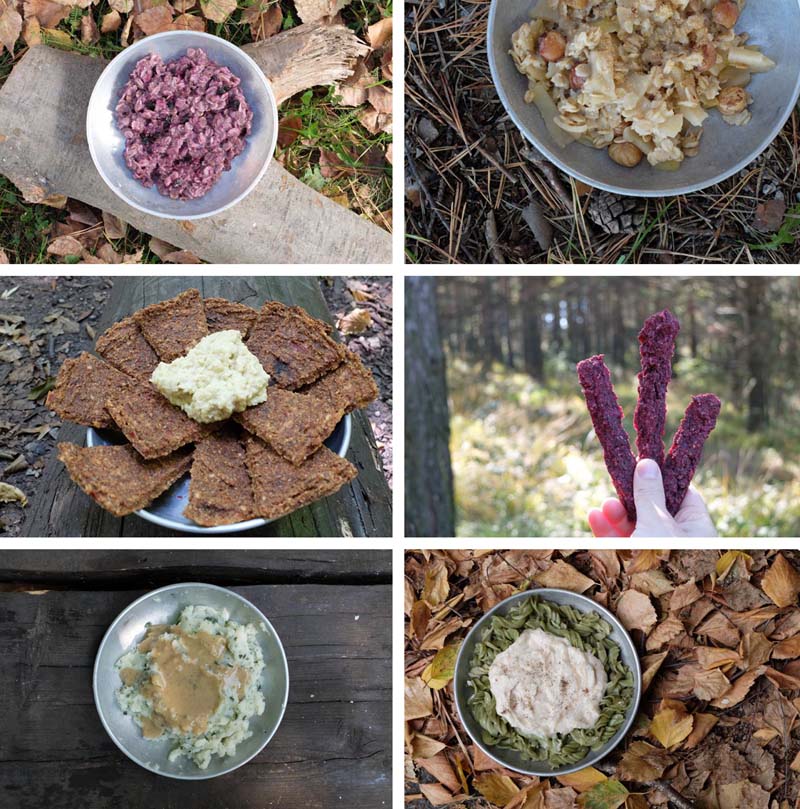
And here’s what the meals looked like packaged.
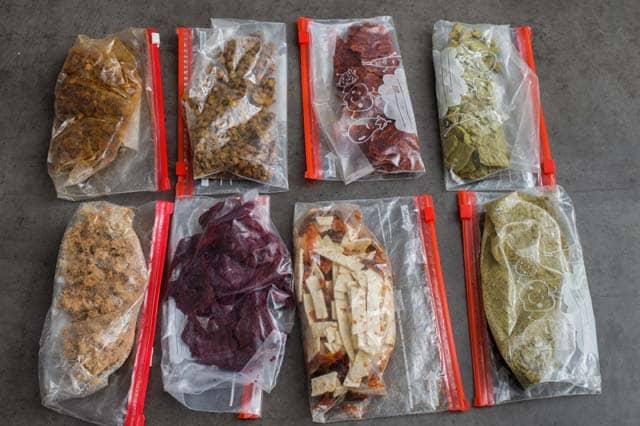
Want the recipes? Get my eBook.
The book has over 50 ultralight recipes plus lots of info on backpacking nutrition and meal planning.
You can get the book for 50% off now.
Happy backpacking!
Image credit: “Making freeze dried food for dinner at c” (CC BY-SA 2.0) by dionhinchcliffe


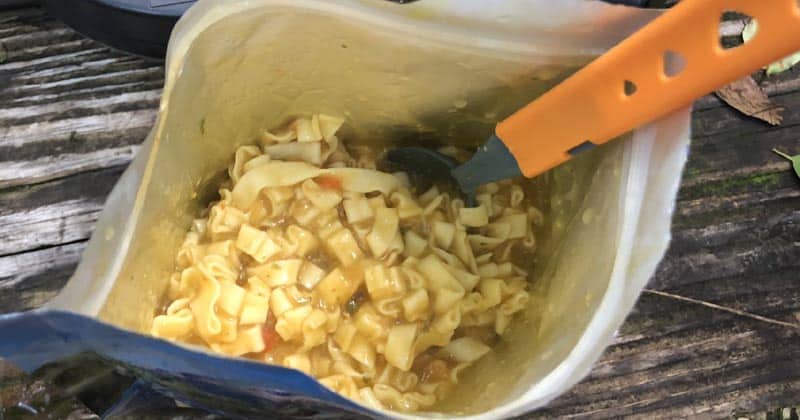
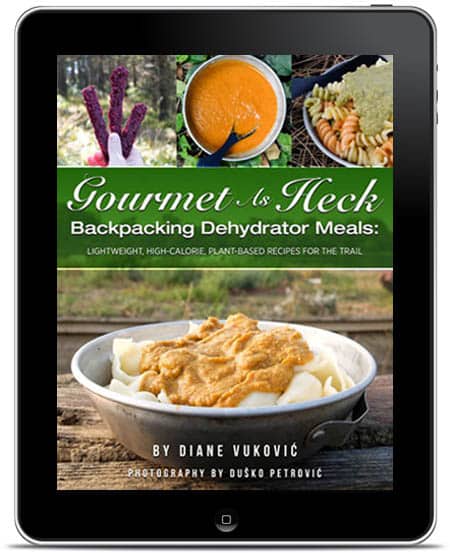
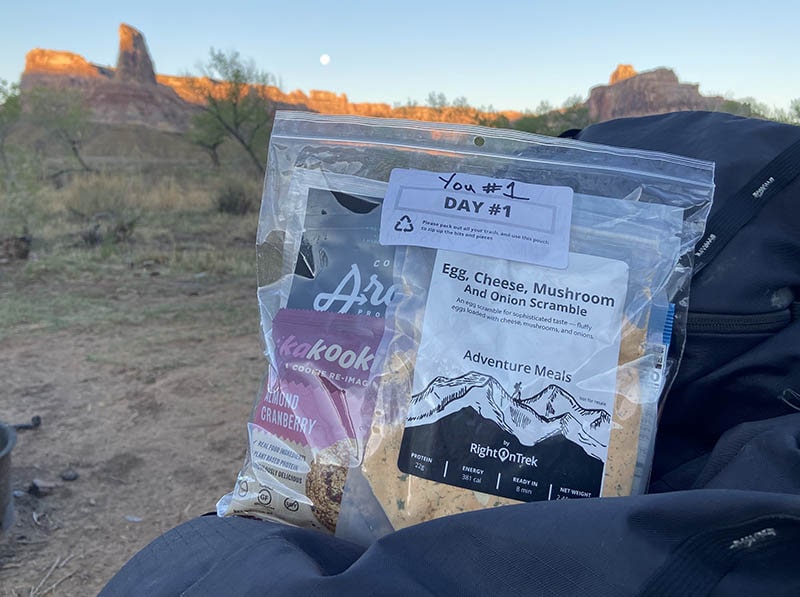
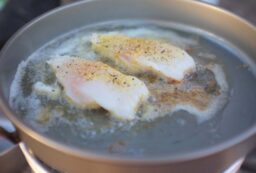
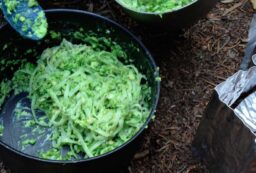
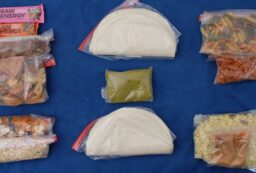







2 Comments
Todd W.
February 2, 2023 at 1:00 amYou gotta try Pinnacle Foods! And PackitGourmet
bob huebner
April 23, 2023 at 5:47 pmi like alpen and mtn house- except mac & cheese(doesnt get soft). For bckpacking- I bring the one with the biggest pouch. I repack the rest in small bags. I then reuse the 1st pouch for the other meals. The packages weigh too much and have create too much garbage. another advantage to freeze dried is no pan to get diry.